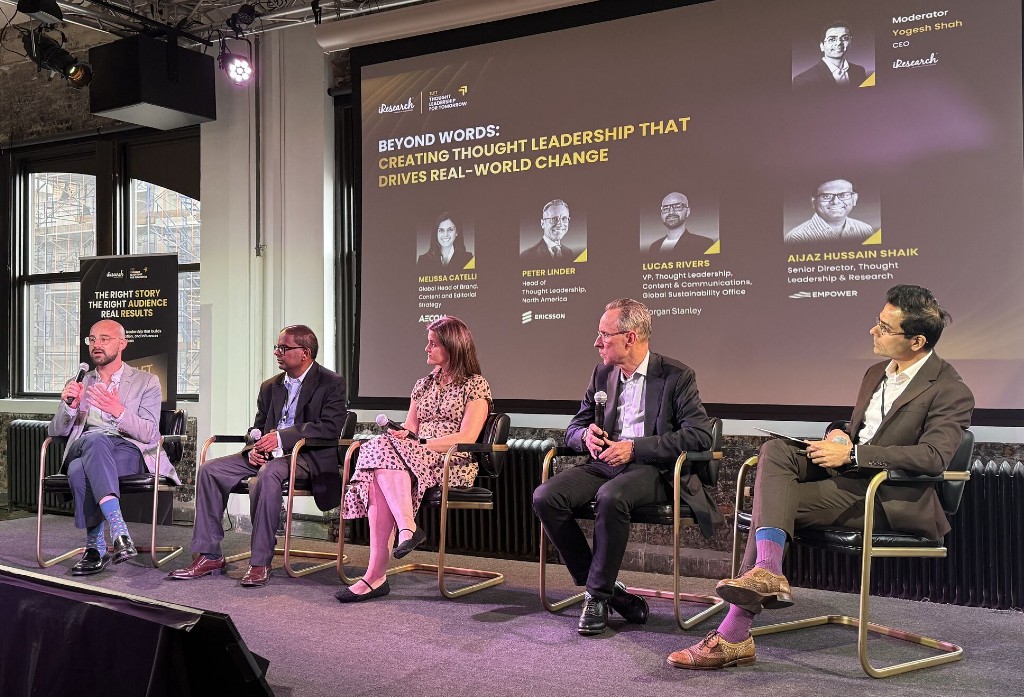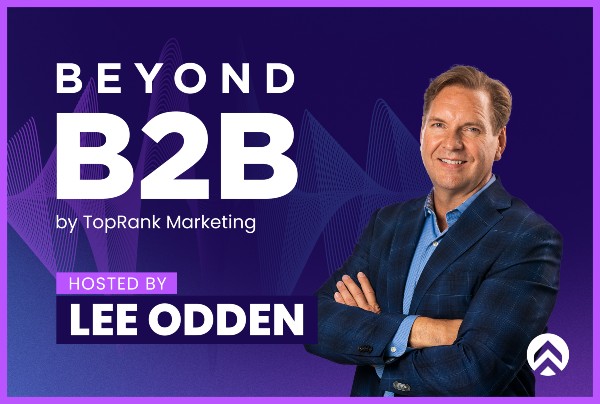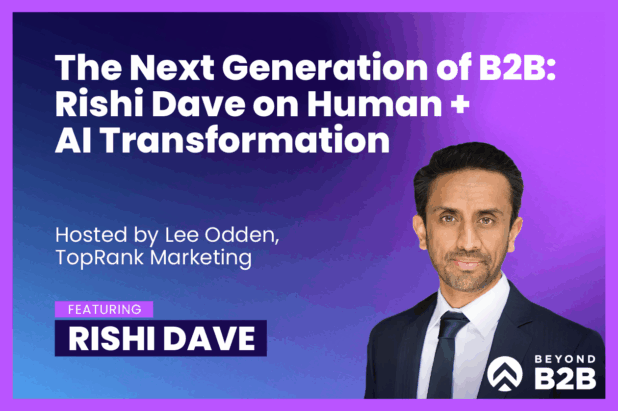B2B executives aren’t asking for more content, they’re asking for more original thinking
At the iResearch Services Thought Leadership for Tomorrow event that I attended in New York recently, one of the messages that stood out to me was that business leaders don’t want more content, they want more clarity.
I know we are years beyond Mark Schaefer’s “Content Shock” but the importance of relevance and quality over quantity bears repeating, especially as we experience this seemingly endless sequence of disruption from the rapid evolution of AI, to economic uncertainty, to global instability.
Understandably, buyers of business solutions are overwhelmed. They’re looking for strategic guidance and sources of truth. They’re looking for brands they can trust. And most importantly, they’re looking for the best answers to ensure confidence and consensus amongst stakeholders and decision makers.

Reflecting on the insights and experiences shared by a really impressive program of panels at the TLFT event, I wanted to dig in to how original research, paired with industry expert insight, experiential content and a strategic approach to thought leadership, is becoming one of the most powerful ways B2B brands can earn credibility and build meaningful trust with their audiences during a time when trust is pretty hard to come by.
1. From mechanical to meaningful: when data informs, thought leadership performs
Building trust in a time when attention is fleeting and it’s becoming harder to know what’s real, is not about using AI-powered workflows to create more content. It’s about publishing meaningful insight that helps your audience to trust, understand and take action. But where do you get the most valuable data for those trust-building insights? How can you best understand the questions your buyers are asking?
Karen Feldman, SVP, Chief Marketing Officer at Iron Mountain shared something I hadn’t heard before:
“87% of enterprise data is dark. The companies that help unlock those insights, and do it with a clear point of view, are the ones that will build trust and momentum.”
Sonja Jacob, Thought Leadership & Content Strategy Leader at Cisco added:
“Thought leadership doesn’t always get the credit it deserves. But when it’s bold, timely, and grounded in real insight, it drives measurable business outcomes.”
The Bright Trends, Bold Strategy panel at the TLFT event offered even more takeaways to help inform the importance of a data informed approach that is more meaningful than mechanical:
- Stop blending in. Thought leadership isn’t a blog schedule. It’s an opportunity to take a stand on what matters.
- Help buyers think differently. As Craig O’Boyle, Global Director – Strategic Insights, Thought Leadership & Executive Experiences at Google shared, “success comes from offering unique perspectives that help people make smarter decisions.”
- Be bold with purpose. Anna Bernasek, Managing Director, Global Head of Insights at State Street put it clearly: “Boldness is not about being loud. It’s about being early and clear with ideas others haven’t said yet.”
Original research gives you the foundation for that boldness. Analysis and insights from the data can help you surface new truths that are timely, relevant and compelling. By leading with unique and relevant insight, you can out-earn attention and trust from the competition to deliver answers amongst the audiences that are actively seeking information and solutions.
2. From reports to resonance: optimized research drives credibility, reach & engagement
While original research builds authority, it’s the voices of credible experts that make your insights more believable and more shareable. As Janine Wegner, Global Integrated Thought Leadership Strategist at Dell Technologies has said in a past interview,
“Influencers help validate the content you bring to market. Their perspectives and amplification build credibility, spark engagement, and often introduce ideas your brand can’t say on its own.”
Combining research with expert perspectives creates a multiplier effect on research based thought leadership content and here’s how:
- More trust. Edelman and LinkedIn found that 62% of decision-makers believe the highest-quality thought leadership comes from respected experts or organizations.
- More engagement. Our own experience at TopRank has show that influencer shared assets typically drive 2-3x higher engagement than brand channels alone.
- More recall. Nielsen research shows influencer content delivers a 79% aided brand recall rate, outperforming unaided formats.
Why does original research content in collaboration with industry experts and influencers work? Because even in B2B marketing, people trust people over brands, especially those with credibility and real-world experience. What better way to build full-funnel credibility than to have the most trusted voices in your industry align with the answers your brand is providing?
To build research reports and B2B brand thought leadership that provides the right answers with the credibility building power of industry experts, we recommend this approach:
- Identify insight gaps. Look for unanswered questions where expert perspective can bring your data to life.
- Involve experts and influencers early. Co-create the narrative instead of adding commentary after the fact.
- Blend internal and external POVs. Give your report dimension with voices that represent the spectrum of your audience from internal SEMs to industry influencers.
- Enable smart distribution. Equip contributors with snippets, statistics, quotes, visuals and video that make it easy to share and even more interesting to consume.
When data-informed research narratives are validated with highly relevant and influential experts, you’re creating the kind of content that doesn’t just perform better it feels more credible. As I’ve said many times over the years,
“In B2B marketing, it’s no longer enough to inform your audience, you must help them feel.”
Adding commentary to research informed brand content from trusted voices that your audience feels a connection to and in formats like interactive, audio, video and real-time that are experiential, can deliver full-funnel outcomes including helping elevate your brand, drive demand and impact revenue.
3. What gets measured, gets funded
No great thought leadership marketing strategy is really that great until it gets implemented. Even when those great strategies are implemented, measuring business impact is essential if you want realize the full value of a continued thought leadership effort. As such, one of the most important messages from the TLFT event was this:
If you want your thought leadership program to grow, you need to measure what matters.
Cindy Anderson, IBM Institute for Business Value – Global Executive, CMO, Thought Leadership Engagement & Eminence, reinforced this perspective with some compelling impact data about thought leadership:
- 88% of executives are influenced by thought leadership
- Thought leadership delivers 156% ROI
- Thought Leadership drives $265 billion in business impact annually
Despite the impact opportunities, many teams still focus on surface metrics-impressions, views, downloads-that don’t tell the full story. Some of these limitations are because the remit of the thought leadership effort doesn’t call for measuring the full impact. In many others, the ability to measure the diverse impact a thought leadership program can have does not exist due to lack of technology, expertise or people resources.
At the TLFT event a panel of CMOs shared some compelling insights on rethinking measurement of thought leadership:
- Map the journey, not just the lead. Lauren Wagner Boyman, Partner, Chief Marketing Officer of KPMG Americas, shared how her team uses AI to “x-ray” the messy middle of the buyer’s journey, identifying which formats are most effective before a lead form is filled.
- Correlate engagement with high-value actions. Rosa Rita, Global Chief Marketing Officer, Asset & Wealth Management at J.P. Morgan, noted that certain content behaviors predict a 70% likelihood of becoming a lead, allowing their team to personalize follow-up. “We’re moving from keywords to conversations.”
- Measure relationships, not just reach. Monica Rowe, Chief Marketing Officer at CARE, reminded us that in some sectors, the return on thought leadership isn’t just traffic-it’s influence.
- Measure brand and demand together. Lauren from KPMG also noted that prospects exposed to both types of content perform better. CRM data, brand surveys, and earned media all contribute to a more complete picture.
Thought leadership works best when it informs, influences, and connects. Measuring those outcomes makes the business case stronger. This is why TopRank Marketing has partnered with Improvado and their AI-enabled data warehouse to offer more end to end analytics and measurement solutions. Research driven thought leadership can deliver full funnel outcomes but just like the tree falling in the forest with no one around to hear, lack of impact measurement may be the thing that stands in the way of scaling or even continuing your thought leadership program.
4. Audience first: how deep listening powers performance-driven thought leadership
If your thought leadership starts with what your brand wants to say, it’s probably just content. If it starts with the questions your audience needs answers to, your thought leadership becomes a source of truth for creating impact in your industry and for your business.
Variations of that idea showed up repeatedly during the TLFT panel, Beyond Words: Creating Thought Leadership That Drives Real World Change where an impressive group of thought leadership experts talked about a listening-first approach:
- Melissa Catelli, Global Head of Brand, Content and Editorial Strategy at AECOM, shared how all of their thought leadership efforts including the Theme Index and Museum Index have become more effective when driven by client insights, not internal ideas.
- Lucas Rivers, Vice President, Thought Leadership, Content, & Communications at Morgan Stanley Global Sustainability Office, introduced a helpful framework: DRAFT – Direction, Relevance, Audience, Format, Trustworthiness which was used to turn listening into a new product offering for LGBTQ investors.
- Aijaz Hussain Shaik, Senior Director, Thought Leadership & Research Empower, emphasized the importance of building research around ongoing conversation vs. static messaging.
- Peter Linder, Head of Thought Leadership North America at Ericsson, shared, “The real job of thought leadership is to understand the customer best, to understand what the customer problems are. What are the outcomes you’re trying to change?”
Not only does listening help B2B brands understand what answers to provide in thought leadership, it can help improve performance, tap the dynamic fluctuations in audience topic demand, develop new product offerings and help power advocates. Some takeways for listening focused thought leadership content from the panel:
- Co-create with stakeholders (and why not relevant industry influencers as well)
- Design for specificity (especially the specific questions buyers want answered)
- Balance messenger and marketer roles (that means authenticity and accountability)
- Measure what matters (don’t be limited to TOFU metrics – bring full funnel measurement and get full opportunity funding)
The result is more relevant and credible thought leadership content that reaches the audience your after, answers their questions, builds brand authority and inspires engagement.
Bottom Line: credibility is a competitive advantage, influence is a force multiplier
I think we can agree that B2B brands are operating in a time of growing skepticism. Buyers don’t need more information, they need better answers. And those answers are more likely to come from brands that listen closely, think originally, and partner with people their audiences already trust.
Original research is one of the most powerful ways to establish that trust. Our believe is that when research is paired with bold ideas, experiential content formats featuring credible experts, thoughtful measurement and consistent listening, it becomes more than just a report to build thought leadership. It becomes a full-funnel credibility engine that can drive impact on brand, demand and revenue objectives.
Want to learn more about building trust with content that leads?
Let’s talk about how we can help turn your brand insights into action.
Listen or watch and subscribe to our new podcast, Beyond B2B Marketing featuring conversations with top B2B marketing pros on the strategies, tactics, tech and inspiration helping marketers go beyond the status quo and break free of boring B2B.




